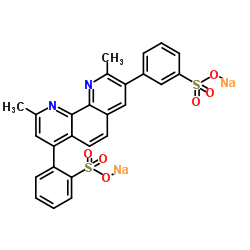浴酮灵二磺酸二钠盐

浴酮灵二磺酸二钠盐结构式

|
常用名 | 浴酮灵二磺酸二钠盐 | 英文名 | 4,7-Diphenyl-1,10-phenanthroline, 2,9-dimethyl disulfonate, disodium salt |
|---|---|---|---|---|
| CAS号 | 52698-84-7 | 分子量 | 564.541 | |
| 密度 | N/A | 沸点 | N/A | |
| 分子式 | C26H18N2Na2O6S2 | 熔点 | 300ºC | |
| MSDS | 美版 | 闪点 | N/A |
|
Leishmania amazonensis: inhibition of 3'-nucleotidase activity by Cu2+ ions.
Exp. Parasitol. 131(1) , 63-8, (2012) Free Cu(2+) is toxic due to the capacity of free copper ions to catalyze the production of reactive oxygen species (ROS) that can modify the structure and/or function of biomolecules. In addition, non-specific binding to enzymes, which modifies their catalyti... |
|
|
Ferroportin and exocytoplasmic ferroxidase activity are required for brain microvascular endothelial cell iron efflux.
J. Biol. Chem. 288(24) , 17932-40, (2013) The mechanism(s) of iron flux across the brain microvasculature endothelial cells (BMVEC) of the blood-brain barrier remains unknown. Although both hephaestin (Hp) and the ferrous iron permease ferroportin (Fpn) have been identified in BMVEC, their roles in i... |
|
|
Molecular insights into the metal selectivity of the copper(I)-sensing repressor CsoR from Bacillus subtilis.
Biochemistry 48(15) , 3325-34, (2009) Bacillus subtilis CsoR (Bsu CsoR) is a copper-sensing transcriptional repressor that regulates the expression of the copZA operon encoding a copper chaperone and a Cu efflux P-type ATPase, respectively. Bsu CsoR is a homologue of Mycobacterium tuberculosis Cs... |
|
|
Cu2+ is required for pyrrolidine dithiocarbamate to inhibit histone acetylation and induce human leukemia cell apoptosis.
Chem. Biol. Interact. 171(1) , 26-36, (2008) Pyrrolidine dithiocarbamate (PDTC) has been considered as a potential anticancer drug due to its powerful apoptogenic effect towards cancer cells, where Cu(2+) plays a distinct yet undefined role. Here we report that Cu(2+) is critically needed for PDTC to in... |
|
|
Cu2+ and Cu+ bathocuproine disulfonate complexes promote the oxidation of the ROS-detecting compound dichlorofluorescin (DCFH).
Anal. Bioanal. Chem 385(5) , 959-61, (2006) The water-soluble Cu+ chelator bathocuproine disulfonate (BCS) is widely used to quantify Cu+ or detect Cu+ formation in Cu2+-initiated oxidation reactions. The dichlorofluorescin (DCFH) assay is commonly used to monitor free radical reactions, reactive oxyge... |
|
|
Differential effects of cysteine and methionine residues in the antioxidant activity of human serum albumin.
Free Radic. Res. 39(1) , 15-20, (2005) Antioxidant properties of human serum albumin (HSA) may explain part of its beneficial role in various diseases related to free radical attack. In the present study, the antioxidant role of Cys and Met was studied by copper-mediated oxidation of human low den... |
|
|
Evaluation of the copper(II) reduction assay using bathocuproinedisulfonic acid disodium salt for the total antioxidant capacity assessment: the CUPRAC-BCS assay.
Anal. Biochem. 392(1) , 37-44, (2009) There is heightened interest in determining antioxidant status of individuals in experimental and clinical studies investigating progression of diseases or diverse aspects of oxidative stress, among others. The aim of this study was to evaluate the copper(II)... |
|
|
Redox-active metals in commercial preparations of lipopolysaccharide: implications for studies of cellular responses to bacterial products.
Cell. Microbiol. 5(4) , 233-43, (2003) The mechanisms by which lipopolysaccharide (LPS) activates cells have been the subject of intense investigation for many years. Whereas much information on this process has been collected for mammalian species, little is known about the signalling path-ways o... |
|
|
Protective role of metallothionein against copper depletion.
Arch. Biochem. Biophys. 451(2) , 112-8, (2006) Copper (Cu) is one of the essential metals and its homeostasis is strictly regulated. Metallothionein (MT) is induced by excess Cu to mask the Cu toxicity. Although the role of MT in Cu toxicity has been explained in terms of Cu sequestration, its role under ... |
|
|
A novel role for the immunophilin FKBP52 in copper transport.
J. Biol. Chem. 279(27) , 27845-8, (2004) FK506-binding protein 52 (FKBP52) is an immunophilin that possesses peptidylprolyl cis/trans-isomerase (PPIase) activity and is a component of a subclass of steroid hormone receptor complexes. Several recent studies indicate that immunophilins can regulate ne... |